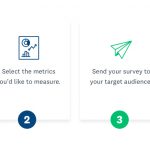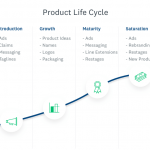How to come up with a brand name your target audience will love
When someone tells their friends or family about your products, they use your brand name. When repeat customers talk to a sales representative or look for your products with an online search, they use your brand name. Your brand’s name is a powerful identifier and the driving force behind word-of-mouth marketing. It can make or break your business.
If you’re starting a new business or launching a new product, you probably want to know how customers will react to a potential brand name before you pick it. With brand name testing, you can gauge consumer sentiment and select the right name for your business or product.
What makes a good brand name
What is a brand name? It’s the foundation of your brand identity. And what makes a brand name work isn’t that it’s fun to say or likeable - it needs to communicate something specific to your customers.
A good brand name doesn’t come from a magic formula. It comes from these essential traits that ensure the name is easy for your business to use and your customers to remember.
- It’s meaningful. It communicates the essence of your brand and your company’s mission, evokes a positive emotion, and creates a clear image in the customer’s mind. Your brand name must fit with your company’s essence to feel authentic.
- It’s distinctive. It stands out from your competitors, and it’s memorable and unique. This helps strengthen brand awareness and reduce customer confusion.
- It’s accessible. Even if you choose an unusual name, your customers must be able to say it, spell it, interpret it, or Google it.
- It’s protectable. You are able to trademark it and get the domain name, and own the overall name (legally and also in general usage). And if your business operates internationally, or plans to, check into worldwide rights as well.
- It’s future-proof. Changing a brand name is a significant undertaking, so be sure your brand name is designed to stand the test of time. Avoid jumping onto short-lived trends and ensure your name is flexible enough to withstand a shift in strategy or new products.
Brand name testing
How do you come up with a brand name that works? By testing multiple potential options and choosing the one with the strongest results.
Brand name testing presents your target audience with several brand name options and asks them to provide feedback on each. With brand name testing, you can compare metrics like appeal, ease of pronouncing, and relevance to identify the most effective brand name.
Let’s take a closer look at why testing potential brand names is important and review how to create a brand name by testing.
How testing your brand name helps you find the strongest option
Your brand name is one of the stickier aspects of branding a business or product. While your ads, products, and product packaging might change over time, your name probably won’t. Get it right the first time by testing several potential brand names before you settle on one option.
By testing several options, you make it easier to choose the right brand name for 4 reasons:
- You have the data you need to get everyone on board. It’s hard for others to counter your hard numbers. Testing proves which brand name is the most liked, empowering you to choose a name and convince coworkers to get behind that choice.
- You know how to make your options stronger. Maybe your audience liked one name the best, but found it a little difficult to pronounce. You can improve its ease of enunciation by changing its spelling.
- You can segment your audience by demographic to see how different groups react to each option. By filtering your survey responses, you can see how different groups (age, gender, location, etc.) feel about each of your potential brand names.
- With concept testing, your business can iterate quickly. By frequently collecting data through agile market research—a type of research that involves continuously gathering data —, your business can react more quickly to changes in the market.
Get in-depth expert analysis and detailed consumer feedback with our Brand Name Analysis solution
Come up with a brand name by taking these 4 steps
Now that you know the importance of testing your brand names before settling on one, you’re ready to start working on your survey. Simply follow these 4 key steps for how to test a brand name:

Related: Why concept testing is important
Select one or more stimulus to test
Though you can test any brand name you’d like, you should pick stimuli that you’re somewhat confident in based on the reactions from people, like coworkers, who’ve already heard the options. Choose brand names in a similar stage of development. If you’re testing a name you’ve put a lot of thought into against a throw away, it isn’t a fair or useful contest.
To make the testing process easier for everyone involved, limit the number of stimuli in your survey. The total number to include in your test depends on whether you want to adopt a monadic survey design or a sequential monadic survey design.
A monadic survey design splits up your audience and presents each with a survey that asks for input on a single stimulus. After you’ve gotten enough feedback on each stimulus, you can pick a winning name by pooling the feedback from all your respondents.
Here’s an example of a brand name test with a monadic design.
Using this survey design, you can ask more questions on each stimulus. In addition, there’s a higher likelihood it results in a relatively short questionnaire, which benefits the quality of your feedback and your survey’s completion rate. However, by only displaying a single stimulus to respondent, you’ll have to survey a larger audience. This can be costly and difficult to carry out.
A sequential monadic survey design asks for feedback on multiple stimuli. Once you’ve gathered responses from enough respondents, you can choose a winning name by looking at the most common responses to each stimuli.
Here’s how a sequential monadic test for a brand name might look.
This design allows you to survey a smaller audience, making it more cost-effective to carry-out. However, if you’re looking to limit the length of your survey, you won’t be able to ask as many questions about each stimulus.
Read more about the reasons to use—and avoid—each design, and how you can set them up.
Choose one or more metrics to test
What makes for a good brand name? The metrics you choose to measure will help you decide.
The questions you ask in your brand name testing survey can be as general or specific as you’d like, depending on your goals for the test. If you want to know whether a certain name will catch people’s attention, for example, you might ask about appeal and uniqueness in specific. Here are some key metrics you might want to include in any brand name testing survey:
- Appeal: Is your brand name attractive to potential customers?
- Believability: Is the message that your brand name conveys credible?
- Purchase intent: Will your brand name motivate people to buy your product?
- Pronounceability: How easy is it to pronounce your brand name?
- Relevance: Does your brand name reflect your audience’s needs and wants?
- Uniqueness: How different is your brand name from others?
The relative value of each metric you measure depends on your goals for the brand name. If you want to find a name that’ll increase sales, purchase intent will be the most vital metric. But if your top goal is to differentiate your brand in a highly competitive market, the uniqueness of your name might be most important.
Likert scale for brand testing
We suggest using the Likert scale to test your metrics. This scale is straightforward, provides consistent choices, and makes it easy for you to analyze the results of your test. If you choose this scale, your questions can use the formula, “How (metric) is the name?” with your answer options going from “Extremely (metric)” to “Not at all (metric).”
For instance, if one of your metrics is pronounceability, here’s how you can measure it:
How easy is it to pronounce the brand name?
- Extremely easy
- Very easy
- Somewhat easy
- Not so easy
- Not at all easy
Sometimes, your respondents’ answers won’t make it clear which name they like best. You can fix this issue by used a forced-answer question that asks respondents to choose their favorite option at the end of the survey. This question can also help you rank the value of each metric to the overall likeability of your name. If respondents consistently choose the most unique name as their favorite, for example, you can assume uniqueness is important to your target market.
Also, you can preface your survey with screener, category, or demographic questions. These questions help you learn more about your respondents and allow you to group them. Learn about demographic questions in our robust page on concept testing.
Looking for assistance from market research pros? Want to refine your skills?
Here are some resources that can help!
Expert Brand Name Analysis: Our Expert Brand Name Analysis solution helps test potential brand names with your target audience with built-in expert methodology and a trusted consumer panel.
Ultimate guide to running market research: This guide includes everything you need to run market research, from designing your survey to analyzing your responses.
Brand name testing survey template: This expert-certified template can help you pinpoint the questions you want to as. You can also edit the questions however you want.
SurveyMonkey Audience: Our global consumer panel lets you survey adults in over 130 countries.
Market Research Services: From translating your survey to delivering your responses faster, our experts will ensure that your research on SurveyMonkey Audience runs smoothly.
Get responses from your target audience
The only way to determine the real likeability of any potential brand names is to have your target audience evaluate them. Find your target profile of individuals and give them an opportunity to provide feedback in one of 2 ways:
- With a focus group, you can collect in-depth feedback on potential brand names through personal discussions. Focus groups are expensive, however, and you probably won’t be able to get input that’s statistically significant.
- SurveyMonkey Audience lets you to specify your target audience and sample size, and start collecting feedback from a representative sample within minutes. This option is faster and more cost-effective than a focus group, but there’s a chance the feedback won’t not be as detailed or in-depth.
Examine your results
Once you’ve collected responses, you’re ready to pick a winning brand name. To make your analysis easier, try using Top 2 Box scores. This scoring method combines positive responses to each question into a single percentage, which makes it easy to compare stimuli across metrics.
If your survey included open-ended questions, make sure you examine the results of these questions as well. To spot the key takeaways from each brand name option, use a word cloud.

We’ve only scratched the surface of concept testing with brand names. To better understand each step, take a look at “The ultimate guide to concept testing.”
Brand name testing survey questions
Your brand name testing survey should measure how your potential brand names stack up against different values. Branding surveys don’t need to be complicated - they should be as short and simple as possible while still maximizing the information you get from your respondents.
Here are some sample brand name testing survey questions:
- What first comes to mind when you see the name?
- How do you like the brand name overall?
- How unique is the brand name?
- How appropriate is the name to the brand?
- How believable is the name?
- How well does the brand name describe the product?
- How modern is the brand name?
- How relevant is the name to your wants and needs?
- How trustworthy does the brand name sound to you?
- Do you find the brand name easy to pronounce?
- Does the brand name remind you of any existing brands? Please specify if so.
- What’s the first thing that comes to mind when you look at the name?
- Based on the brand name, how likely are you to use the services of this company?
- Which of these names best aligns with our mission to [insert company mission here]?
- Which of these [insert industry vertical] names do you feel most embodies [insert values here]?
- Do you have any suggestions about the brand name?
Brand name testing is part of the product life cycle
Perform brand name testing during the development, growth, saturation, and decline stages of the product life cycle—when you’re either launching new brands or rebranding existing ones.

In the development and growth stages, you’ll probably be looking for broad feedback that’ll help you make overarching decisions about your business or products. This is your opportunity to ask respondents to choose between several very different brand names, for example. Because your brand is new in this stage, it’s the best time to field directional feedback on your brand name.
In the saturation and decline stages, you’ll probably be searching for more specific feedback on your brand name. This is the time to ask respondents focused questions about changes to the spelling, abbreviations, or theme of your name, for example. It’s also the time to think about sampling your loyal customer base to see if they’re on board with a rebranding.
You don't have to go it alone
Our Brand Name Analysis solution takes care of each step so you can save loads of time and pick a winning brand name.
4 best practices for brand name testing
By adhering to the best practices for brand name testing, you can improve the quality of your feedback and the and analysis. Here are 4 things to keep in mind as you test your brand name:
- Ask the same questions about each stimulus. The only way to compare your options fairly is to measure the same metrics for each potential brand name.
- Make sure your sample pool is statistically significant. To ensure your results meet your criteria, you can always use our panel.
- Keep your survey to the point. We recommend asking no more than 30 questions in your brand name testing survey. More questions increase the chance that respondents put less thought into their responses or drop out of your survey.
- Put your results in perspective with control options. If you’re rebranding an existing business or product, include your current brand name in your survey. The results will help you decide whether or not a rebranding will be beneficial. You might also want to include the brand names of one or more competitors to show you how your potential names measure up to the competition.
Key takeaways
The importance of a brand name can’t be overstated - it’s crucial to the success of your business. A task this vital shouldn’t be left to intuition or guesses, but tested thoroughly and carefully to determine exactly the right name for your company.
Discover more resources

Understand Your Target Market To Fuel Explosive Brand Growth
Brand marketing managers can use this toolkit to understand your target audience, grow your brand, and prove ROI.

See SurveyMonkey In Action: Event Registration And Feedback

Hornblower Enhances Global Customer Experiences
Discover how Hornblower uses SurveyMonkey and powerful AI to make the most of NPS data, collect customer insights, and improve customer experiences.

Marketing Trends: 3 Strategies To Stay Relevant And Ready For What's Next
New SurveyMonkey research reveals critical insights on the state of marketing. Discover marketing trends to fuel your strategies and stay relevant.